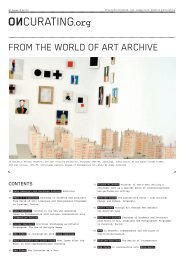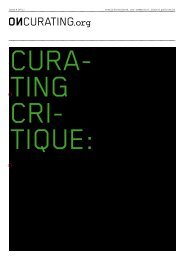You also want an ePaper? Increase the reach of your titles
YUMPU automatically turns print PDFs into web optimized ePapers that Google loves.
064 Issue # 11/11 : PublIc Issues<br />
language <strong>as</strong> well. What we call third space may well be<br />
seen <strong>as</strong> third language.<br />
Translation and Mimicry<br />
Seçil: Özge, you have been emph<strong>as</strong>ising the issue of trans-<br />
lation. Would you expand on that with concrete examples?<br />
It sounds to me somewhat optimistic to explain Oda Projesi<br />
through the notion of translator-ship; it sounds even a<br />
little bit too positive.<br />
Özge: Authorship is something rigid; it is about signing a<br />
completed work. Oda Projesi is about a series of intentions<br />
and proposals, just like the difference between two<br />
different translations of the same text. A translator may<br />
come up with a completely different translation in compari-<br />
son with others because what he or she produces is a pro-<br />
posal of the original text in a second language. When<br />
I speak of translation, I also refer to the play with the<br />
inner dynamics of translation – a translation made with<br />
the intention of generating a common language. And I don't<br />
give a single meaning to the word. What we were doing in<br />
our long-term projects, realised outside the Galata neigh-<br />
bourhood, w<strong>as</strong> the translation of the everyday life of<br />
these new neighbourhoods. We did exactly what people were<br />
doing in their everyday lives over there and we didn't<br />
add any object to these spaces. What we did w<strong>as</strong> the trans-<br />
lation of space; and there w<strong>as</strong> also the translation of<br />
everyday life into what w<strong>as</strong> being experienced within the<br />
art space. Seçil, perhaps you could further explain what<br />
you have in mind in relation to the link between<br />
translation and optimism.<br />
Seçil: Claiming that Oda Projesi h<strong>as</strong> the position of a<br />
translator means saying that Oda Projesi h<strong>as</strong> done a good<br />
job by transforming an intention from a process into an<br />
outcome. I would suggest the concept of mimicry instead<br />
of translation. I think there is more authorship in trans-<br />
lation, where<strong>as</strong> in mimicry there is some sort of repetition<br />
and de-authorization. The translator proposes her/his<br />
own translation of a text, s/he rewrites the original<br />
text in her/his own language. If you think of mimicry in<br />
the light of the concept of the original, you can think<br />
of it <strong>as</strong> an interpretation of the original. The optimism I<br />
am talking about lies in an <strong>as</strong>sumption that there can be<br />
no bad translation. When you, <strong>as</strong> a translator, say "I<br />
see it in this way, therefore I give voice to it in this<br />
way," this provides you with a kind of defense.<br />
Derya: The issue of mimicry seems crucial to me. Is there<br />
a potential creativity in mimicry? At what point do trans-<br />
lation and mimicry converge? What I have in mind here<br />
is that translation is more a matter of mediating than a<br />
question of authorship. And interpretation is present in<br />
both mimicry and translation, I would say.<br />
Özge: I definitely wouldn't regard translation <strong>as</strong> an end<br />
result, which explains my emph<strong>as</strong>is on the word translation;<br />
everyone produces a specific version of the text, and this<br />
refers to a state of enunciation. Indeed, translation<br />
is a type of mimicry, the mimicry of the original text. At<br />
this point, differentiation between good and bad disappears;<br />
this is how I define translation that operates outside<br />
the context of art; even the translator's mood or frame of<br />
mind h<strong>as</strong> an impact on how the enunciation is built up.<br />
Just like Derya, I share the view that the translator is<br />
actually a mediator, and therefore I consider the experience<br />
of Oda Projesi through the context of translation.<br />
Interpretation is definitely present within translation<br />
(a notion some people would certainly object to). The<br />
state of translation is a<br />
stance that resists literal<br />
perceptions and rigid de-<br />
finitions.<br />
Derya: We are talking about<br />
a common production but at<br />
the end the signature appears<br />
to belong to the artist(s)<br />
and not to the people that<br />
have had a part in the pro-<br />
ject. This is because the<br />
artist is positioned and acts<br />
within the art world <strong>as</strong> long<br />
<strong>as</strong> he or she holds onto<br />
the artist's identity. But<br />
this is not doom and gloom.<br />
One can raise questions<br />
about authorship and problematize<br />
the art world, and<br />
such questioning can lead to<br />
institutional critique. 9<br />
Özge: Instead of collabo-<br />
ration with groups, can we<br />
perhaps define what is<br />
happening <strong>as</strong> the merging of<br />
different groups on a plat-<br />
form facilitated by Oda Pro-<br />
jesi? In that sense, does<br />
Oda Projesi let itself dis-<br />
appear? It's like when the<br />
radio project w<strong>as</strong> halted<br />
for a day when there w<strong>as</strong><br />
a funeral in the neighbour-<br />
hood – that is, allowing<br />
projects to conform to the<br />
flow of everyday life. 10 A<br />
normal radio station cannot<br />
afford a similar interruption<br />
for it is financially<br />
dependent on broadc<strong>as</strong>ting<br />
advertisements. But our<br />
radio project could be sus-<br />
pended or make swift changes<br />
to its programme. Coming<br />
back to the issue of signature,<br />
I think when there is<br />
no audience the signature<br />
also fades away automatically.<br />
And in that sort of<br />
relational, live, collective<br />
projects, we call whoever<br />
isn't participating the<br />
audience.<br />
Seçil: I don't think that<br />
signature ce<strong>as</strong>es in this<br />
instance either; it cannot<br />
ce<strong>as</strong>e. For example, there<br />
w<strong>as</strong> no audience in Özge's<br />
bring something From Home<br />
and Günes¸'s locked Room<br />
(both presented within A<br />
Day in Oda) but there were<br />
still signatures. Why?<br />
Because we decided to add<br />
them to our résumé and<br />
count them <strong>as</strong> works of Oda<br />
Projesi. Another option<br />
would be to say that we did<br />
9<br />
Here I refer<br />
to what is called<br />
"institutional<br />
critique" in art<br />
history, which in-<br />
cludes self-reflex-<br />
ive art practices<br />
that treat the art<br />
world and its con-<br />
ventions in a<br />
critical f<strong>as</strong>hion.<br />
The works of Hans<br />
Haacke are good<br />
examples of this.<br />
10<br />
The radio project<br />
101.7 eFeM is the<br />
l<strong>as</strong>t work of Oda<br />
Projesi before<br />
moving out of the<br />
neighbourhood. The<br />
space of Oda Pro-<br />
jesi w<strong>as</strong> trans-<br />
formed into a<br />
radio studio in<br />
collaboration with<br />
Matthieu Pratt<br />
from February 19th<br />
to March 16th,<br />
2005. The radio<br />
programmes focused<br />
on the gentrification<br />
process of<br />
the neighbourhood.<br />
The radio w<strong>as</strong><br />
accessible only to<br />
the neighbourhood<br />
residents and<br />
those who came to<br />
Oda Projesi space<br />
especially<br />
to listen to the<br />
radio station.


![Download as PDF [10.6 MB]](https://img.yumpu.com/4266533/64/500x640/download-as-pdf-106-mb.jpg)

